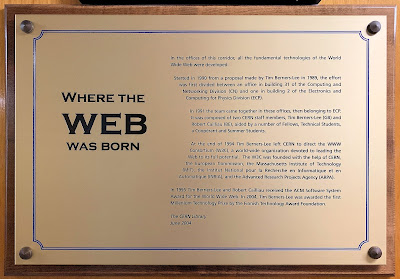You may also have read that I helped launch the union of CERN alumni last year, participating in its baptismal celebration, First Collision. In fact, the most exciting moment in the life of a particle collider is when physicists observe the first collisions.
It was natural and nearly compulsory that I volunteered when the alumni were asked to help with the CERN Open Days 2019.
After being assured of my stay, I took the train from Freiburg to Geneva. When I stepped onto streetcar number 18, I was excited because all trams and buses flew CERN flags and those of the Open Days.

|
| The following morning, at my hostel. View of the Alps and Mont Blanc |

|
| The LHC is shut down until 2021 for an upgrade to reach its final energy of 14 TeV. |

|
|
LHC superconducting magnet string underground. You barely see the curvature of the ring tunnel. |
Then, I began exploring my former workplace.

|
|
A development I lived through. Click to enlarge. I frequently had coffee with Robert Cailliau. |

|
| I only knew that Werner Heisenberg was a table tennis champion. |

|
| A unique coffee only found in the Geneva region, the renversé |

|
|
In the evening, there was a reception for the alumni helping with the
Open Days at the tennis club "Le Smash." Note the white cylinder hanging from the wall: An RP radiation monitor (see text below) |

|
|
On Saturday morning, the radiation protection crew is waiting for
visitors. In front, right: one of the radiation measuring instruments on display (©RP CERN). |

|
|
While we were waiting at our stand at 9:18 a.m. for our first
customers, there was already a waiting time of two hours to visit the ATLAS experimental area. |
*Sievert (Sv) is the SI unit when measuring radiation. This is a big unit, so in radiation protection, doses are expressed in mSv, μSv, or even nSv

|
| Bananas are good for your health. |
A passenger on a plane traveling from Europe to the States is exposed to a dose of 50 μSv due to cosmic rays. Doses to flying staff accumulate, so pilots and cabin crews are professionally exposed workers. While at CERN, people working in radioactive areas or with radiation sources wear dosemeters to determine their personal radiation doses; those to flying staff are evaluated by calculation. In fact, exposure to cosmic rays is well-known for the routes planes take on a routine basis.

|
| Lying in the sand |
At the exhibition, we had worse. The sand from a beach at Guarapari, Brazil, gave a dose rate of 230 nSv/h. This is due to a high concentration of natural Thorium. They operate Thorium mines in Brazil. Would Einstein go to Guarapari Beach? Definitely.

|
| On the evening of the first Open Day, again, the view from my hostel. |
All these demonstrations were very popular with our visitors and, in most cases, instrumental in dissipating their underlying angst.

|
| The Sunday afternoon crew (©RP CERN) |
At the end of those highly successful Open Days at CERN, I was tired but simultaneously satisfied, having helped my former colleagues sell our trade to the visiting public.

|
|
Drinking my well-deserved craft beer and relaxing in the evening sun on the terrace of the CERN restaurant. |

|
| Same view in full moon: Goodnight and goodbye, CERN |




Before going to install an instrument at KEK High Energy Physics laboratory at Mt. Tsukubs, Japan back in 1984. I had to have a crash course on radiation and had to wear 3 radiation badges! The instrument I was installing was used on the electrons and not the nucleus, so once the beam was shut down the radiation also stopped whereas on the nucleus rings, the radiation would last for a couple of days and disperse in all directions. Likely they were installing a 4th ring while I was there and the accelerator was shut down. So I received more radiation from my flight over then while I was there. The training was still invaluable and I also enjoyed your explanation in this article. Thanks
ReplyDelete